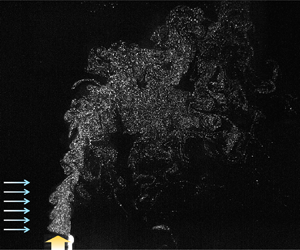Crossref Citations
This article has been cited by the following publications. This list is generated based on data provided by
Crossref.
Kang, Yeeun
Park, Jooyeon
and
Park, Hyungmin
2021.
Particle leakage through the exhalation valve on a face mask under flow
conditions mimicking human breathing: A critical assessment.
Physics of Fluids,
Vol. 33,
Issue. 10,
Choi, Daehyun
Byun, Jungwon
and
Park, Hyungmin
2022.
Analysis of liquid column atomization by annular dual-nozzle gas jet flow.
Journal of Fluid Mechanics,
Vol. 943,
Issue. ,
Park, Jooyeon
Lee, Kwang Suk
and
Park, Hyungmin
2022.
Optimized mechanism for fast removal of infectious pathogen-laden aerosols in the negative-pressure unit.
Journal of Hazardous Materials,
Vol. 435,
Issue. ,
p.
128978.
Park, Jooyeon
Lee, Kwang Suk
and
Park, Hyungmin
2022.
Optimized Mechanism for Fast Removal of Infectious Pathogen-Laden Aerosols in the Negative-Pressure Unit.
SSRN Electronic Journal ,
Zhao, Kangchun
Xia, Zhixun
Ma, Likun
Duan, Yifan
Zhang, Jiarui
Feng, Yunchao
Cheng, Binbin
and
Yang, Pengnian
2023.
Large-eddy simulation of gas-particle two-phase jet into a supersonic crossflow.
Physics of Fluids,
Vol. 35,
Issue. 2,
Newland, Eric L.
and
Woods, Andrew W.
2023.
On particle fountains in a crossflow.
Journal of Fluid Mechanics,
Vol. 964,
Issue. ,
Zhu, Hao
Guo, Haizhou
Sun, Junjie
Tian, Hui
and
Cai, Guobiao
2023.
Research Progress on Active Secondary Jet Technology in Supersonic Flow Field of Aerospace Propulsion Systems.
Fluids,
Vol. 8,
Issue. 12,
p.
313.
Chen, Xuanren
Wang, Hui
Wang, Chao
Wang, Xiangyu
Wang, Ning
and
Liu, Xiang
2023.
Numerical investigation into fuel–air mixing characteristics and cold flow field of single hydrogen-rich Micromix nozzle.
Fuel,
Vol. 332,
Issue. ,
p.
126181.
Zhao, Zilong
Guo, Zhiwei
Zuo, Zhigang
and
Qian, Zhongdong
2024.
Trapping of inertial particles in a two-dimensional unequal-strength counterrotating vortex pair flow.
Physical Review Fluids,
Vol. 9,
Issue. 2,
Hoque, Mohammad Mainul
Joshi, Jyeshtharaj B.
Evans, Geoffrey M.
and
Mitra, Subhasish
2024.
A critical analysis of turbulence modulation in particulate flow systems: a review of the experimental studies.
Reviews in Chemical Engineering,
Vol. 40,
Issue. 4,
p.
511.
Ma, Likun
Xu, Luxi
Zhao, Kangchun
Yang, Pengnian
Feng, Yunchao
Chen, Binbin
and
Xia, Zhixun
2024.
Preferential concentration in supersonic gas-particle two-phase transverse jets.
Particuology,
Vol. 94,
Issue. ,
p.
29.
Li, Chao
Che, Yanhong
Lei, Rong
Li, Junjie
and
Hu, Chunbo
2025.
Study on the mixing characteristics of powder fuel in supersonic flow.
Acta Astronautica,
Vol. 234,
Issue. ,
p.
398.
Yang, Pengnian
Ma, Likun
Xia, Zhixun
Duan, Yifan
Feng, Yunchao
Chen, Binbin
and
Chen, Xinyuan
2025.
Vortex–Particle Coupling of Polydisperse Microparticles in Supersonic Transverse Jets.
AIAA Journal,
p.
1.
Zhao, Zilong
Zuo, Zhigang
and
Qian, Zhongdong
2025.
Trapping and leakage of heavy inertial particles in an unequal strength counter-rotating vortex pair.
Journal of Fluid Mechanics,
Vol. 1024,
Issue. ,
Zheng, Caichao
Ji, Chenzhen
Wang, Mengming
Farhan, Sheikh Muhammad
Lu, Shikang
Ke, Enlei
Zhu, Tong
Gao, Chuang
and
Zhao, Dan
2025.
Numerical investigations on hydrogen-enriched fuel–air mixing characteristics in a single micromix nozzle for the gas turbine combustor.
Physics of Fluids,
Vol. 37,
Issue. 9,
Yang, Pengnian
Ma, Likun
Xia, Zhixun
Feng, Yunchao
Chen, Binbin
Duan, Yifan
Li, Chaolong
and
Chen, Xingyuan
2025.
An experimental approach for particle-laden transverse jets in high-enthalpy supersonic flows with multimodal diagnostics.
Experiments in Fluids,
Vol. 66,
Issue. 12,
Park, Jingyu
Won, Yunjae
Lee, Gilbong
and
Kang, Seongwon
2025.
Near-field characteristics of drift under crossflow conditions.
Physics of Fluids,
Vol. 37,
Issue. 3,
Kang, Yeeun
Sim, Jaemin
Chung, Junho
Yim, Yeongwoo
Son, Seunghee
and
Park, Hyungmin
2025.
Condition for uniform discharge in the two-phase flows in a manifold pipe.
Physics of Fluids,
Vol. 37,
Issue. 3,
Yang, Pengnian
Ma, Likun
Xia, Zhixun
Feng, Yunchao
Chen, Binbin
Zhao, Libei
and
Chen, Xingyuan
2026.
Polydisperse microparticles distribution in supersonic crossflow: An experimental study of the influence of momentum flux and mass loading.
Aerospace Science and Technology,
Vol. 168,
Issue. ,
p.
110975.

 $St = 0.01\text {--}27.42$). Without crossflow, there is no dominant vortical structure along the horizontal direction; thus, the particles are not dispersed significantly out of the jet core in most cases, except for the case with the highest particle inertia (i.e.
$St = 0.01\text {--}27.42$). Without crossflow, there is no dominant vortical structure along the horizontal direction; thus, the particles are not dispersed significantly out of the jet core in most cases, except for the case with the highest particle inertia (i.e.  $St$). With crossflow, on the other hand, counter-rotating vortex pairs appear above the jet exit and become stronger as the velocity ratio decreases. With a lower velocity ratio, the vortices are tilted more toward the leeward side and dissipate faster. Driven by the vortex pairs, the drag force acting on the particles becomes stronger and, thus, particles with
$St$). With crossflow, on the other hand, counter-rotating vortex pairs appear above the jet exit and become stronger as the velocity ratio decreases. With a lower velocity ratio, the vortices are tilted more toward the leeward side and dissipate faster. Driven by the vortex pairs, the drag force acting on the particles becomes stronger and, thus, particles with  $St < 1.0$ are dragged out of the jet core following the rotation of the vortices. Those with
$St < 1.0$ are dragged out of the jet core following the rotation of the vortices. Those with  $St \simeq 1.0$ are concentrated between the vortex pairs before the vortices collapse. When
$St \simeq 1.0$ are concentrated between the vortex pairs before the vortices collapse. When  $St \gg 1.0$, particles are simply transported by the inertial effect. Finally, we suggest different regimes for particle dispersion (concentration) as classified by the Stokes number and velocity ratio, and elucidate their mechanisms, which are further extended to empirical particle dispersion models.
$St \gg 1.0$, particles are simply transported by the inertial effect. Finally, we suggest different regimes for particle dispersion (concentration) as classified by the Stokes number and velocity ratio, and elucidate their mechanisms, which are further extended to empirical particle dispersion models.

